
The Warsaw Ghetto was the largest of the Nazi ghettos during World War II and the Holocaust. It was established in November 1940 by the German authorities within the new General Government territory of occupied Poland. At its height, as many as 460,000 Jews were imprisoned there, in an area of 3.4 km2 (1.3 sq mi), with an average of 9.2 persons per room, barely subsisting on meager food rations. Jews were deported from the Warsaw Ghetto to Nazi concentration camps and mass-killing centers. In the summer of 1942, at least 254,000 ghetto residents were sent to the Treblinka extermination camp during Großaktion Warschau under the guise of "resettlement in the East" over the course of the summer. The ghetto was demolished by the Germans in May 1943 after the Warsaw Ghetto Uprising had temporarily halted the deportations. The total death toll among the prisoners of the ghetto is estimated to be at least 300,000 killed by bullet or gas, combined with 92,000 victims of starvation and related diseases, the Warsaw Ghetto Uprising, and the casualties of the final destruction of the ghetto.
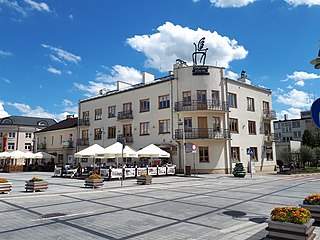
Piaseczno is a town in east-central Poland with 47,660 inhabitants. It is situated in the Masovian Voivodeship, within the Warsaw metropolitan area, just south of Warsaw, approximately 16 kilometres south of its center. It is a residential area and a suburb of Warsaw. It is the capital city of Piaseczno County.
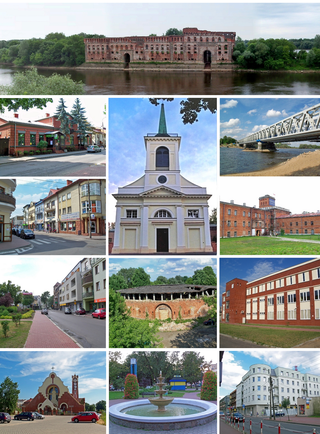
Nowy Dwór Mazowiecki, often simply referred to as Nowy Dwór, is a town in east-central Poland with ca. 42500 inhabitants (2008). It is situated in the Masovian Voivodeship ; previously, it was in Warszawa Voivodeship (1975–1998). It is the capital of Nowy Dwór County.

Pruszków is a city in east-central Poland, capital of Pruszków County in the Masovian Voivodeship. Pruszków is located along the western edge of the Warsaw metropolitan area.

Zawiercie ( ) is a town in southern Poland located in the Silesian Voivodeship with 49,334 inhabitants (2019). It is situated in the Kraków-Częstochowa Upland near the source of the Warta River. The town lies near the historical region of Silesia, but belongs to Lesser Poland.

The Warsaw Ghetto Uprising was the 1943 act of Jewish resistance in the Warsaw Ghetto in German-occupied Poland during World War II to oppose Nazi Germany's final effort to transport the remaining ghetto population to the gas chambers of the Majdanek and Treblinka extermination camps.

The Warsaw concentration camp was a German concentration camp in occupied Poland during World War II. It was formed on the base of the now-nonexistent Gęsiówka prison, in what is today the Warsaw neighbourhood of Muranów, on the order of Reichsführer-SS Heinrich Himmler. The camp operated from July 1943 to August 1944.

Umschlagplatz was the term used during The Holocaust to denote the holding areas adjacent to railway stations in occupied Poland where Jews from ghettos were assembled for deportation to Nazi death camps. The largest collection point was in Warsaw next to the Warsaw Ghetto. In 1942 between 254,000 – 265,000 Jews passed through the Warsaw Umschlagplatz on their way to the Treblinka extermination camp during Operation Reinhard, the deadliest phase of the Holocaust in Poland. Often those awaiting the arrival of Holocaust trains, were held at the Umschlagplatz overnight. Other examples of Umschlagplatz include the one at Radogoszcz station - adjacent to the Łódź Ghetto - where people were sent to Chełmno extermination camp and Auschwitz.
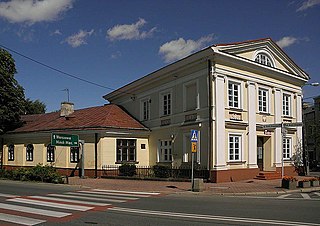
Grójec is a town in eastern Poland, located in the Masovian Voivodeship, about 40 kilometres south of Warsaw. It is the capital of the urban-rural administrative district Grójec and Grójec County. It has 16,674 inhabitants (2017). Grójec surroundings are considered to be the biggest apple-growing area of Poland. It is said that the region makes up also for the biggest apple orchard of Europe. Statistically, every third apple sold in Poland is grown in Grójec – a unique local microclimate provides for their beautiful red colour.

Zakroczym is a small town in the Masovian Voivodeship, Poland. It is located at around 52°26′16″N20°36′43″E. The Vistula River flows through the town. Zakroczym has a long and rich history: in the Kingdom of Poland and the Polish–Lithuanian Commonwealth, it was the capital of an administrative unit (ziemia), part of Mazovian Voivodeship. Also, Zakroczym was a royal town of the Crown of the Kingdom of Poland. The town lies at the intersection of two main roads - national road 62, and national road 7.

Muranów is a neighbourhood in the districts of Śródmieście (Downtown) and Wola in central Warsaw, the capital of Poland. It was founded in the 17th century. The name is derived from the palace belonging to Simone Giuseppe Belotti, a Venetian architect, who originally came to Warsaw from the island of Murano. It is the northernmost neighbourhood of the downtown area.

Szczuczyn is a town in Grajewo County, Podlaskie Voivodeship, Poland. As of 2004, it has a population of 3,602.
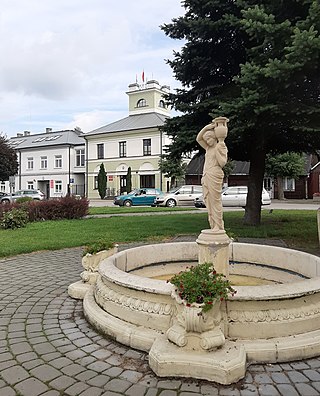
Mogielnica is a town in Grójec County in Masovian Voivodeship, Poland, with 2,475 inhabitants (2004) and an area of 141.56 square kilometres. It is the seat of Gmina Mogielnica.
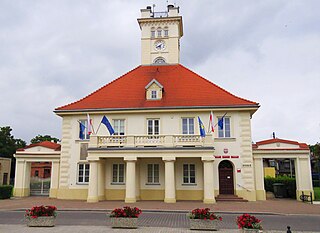
Błonie is a town in Warsaw West County, Masovian Voivodeship, Poland, with a population of 12,058 as of December 2021.

POLIN Museum of the History of Polish Jews is a museum on the site of the former Warsaw Ghetto. The Hebrew word Polin in the museum's English name means either "Poland" or "rest here" and relates to a legend about the arrival of the first Jews to Poland. Construction of the museum in designated land in Muranów, Warsaw's prewar Jewish quarter, began in 2009, following an international architectural competition won by Finnish architects Rainer Mahlamäki and Ilmari Lahdelma.
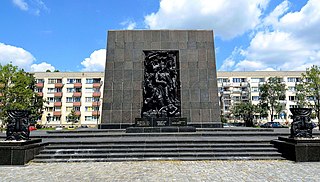
The Monument to the Ghetto Heroes is a monument in Warsaw, Poland, commemorating the Warsaw Ghetto Uprising of 1943 during the Second World War. It is located in the area which was formerly a part of the Warsaw Ghetto, at the spot where the first armed clash of the uprising took place.

Ulica Próżna is a historical street in the Śródmieście Północne neighbourhood of the borough of Śródmieście in Warsaw, Poland. It is the only former Warsaw Ghetto street still featuring as many as four tenement houses.

The Umschlagplatz Monument is a monument located in Warsaw at Stawki Street, in the former loading yard, where from 1942 to 1943 Germans transported over 300,000 Jews from the Warsaw Ghetto to the death camp in Treblinka and other camps in the Lublin district.

In the best-known photograph taken during the 1943 Warsaw Ghetto Uprising, a boy holds his hands over his head while SS-Rottenführer Josef Blösche points a submachine gun in his direction. The boy and others hid in a bunker during the final liquidation of the ghetto, but they were caught and forced out by German troops. After the photograph was taken, all of the Jews in the photograph were marched to the Umschlagplatz and deported to Majdanek extermination camp or Treblinka. The exact location and the photographer are not known, and Blösche is the only person in the photograph who can be identified with certainty. The image is one of the most famous photographs of the Holocaust, and the boy came to represent children in the Holocaust, as well as all Jewish victims.



















